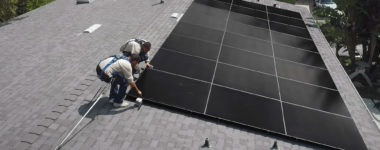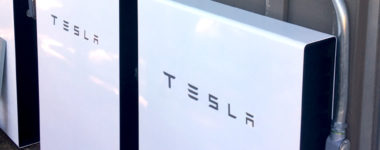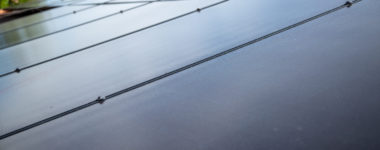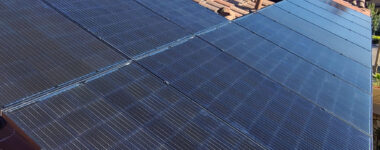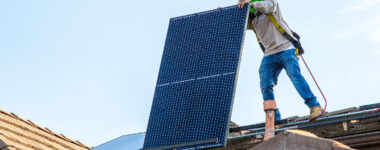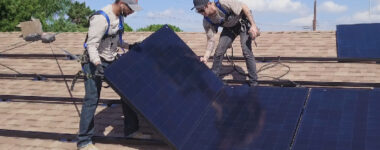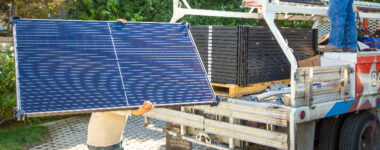Solar Installation | Solar Panels, Battery Storage, Roofing, HVAC
Solar Panel Installation Companies Santa Ana Solar Costs Skyrocketing in Santa Ana Santa Ana is a lovely city that enjoys some of the most excellent weather in California. So, if you plan on going Solar, Semper Solaris is the company to turn to for help. They have over a decade of experience as the nation's largest household solar and energy storage business. And they strive to make you feel less stressed amid power outages and growing energy expenses. Identify the best Semper Solaris solar plan in Santa Ana, California, based on your budget and energy demands. Keep reading to know more! What Are the Advantages of Going With The Best Solar Companies In Santa Ana? It's no secret that California is a pioneer in environmental preservation. Because of the advantages of solar energy, every house in the area is investing in it. The sufficient sunlight that California has been blessed with offers a clean energy alternative for many of its citizens. Residents in Santa Ana and other Californian locales may wonder whether solar power is worthwhile because of the cloudy weather. But clouds aren't something to be concerned about! Further, even though it is gloomy, solar panels may still produce electricity from the sun's radiation. Think About It for A Second. Using solar energy makes it possible for homeowners to reduce their electricity bills. Then again, who doesn't dream of the day when they don’t have to worry about the local electric company? Hence, it's just easier to go solar right now. Investing in solar has never been more valuable, and living secluded has never been simpler. As a result, contact your local Santa Ana Semper Solaris office for more information. Why Go Solar in Santa Ana? Santa Ana residents are lucky that they enjoy pleasant weather throughout the year! With over 12 months of direct sunlight each year, Santa Ana's sunshine is a proven money-saving for those who want to go solar. The Santa Ana region may have chilly winter and boiling summer, which most homeowners choose to moderate by turning on their AC's or heater. You can save money by installing a solar energy system if you constantly utilize a heater or an air conditioner. Consequently, the quantity of solar power produced may exceed the amount of energy used by your house. In this case, you may store the extra energy for later use. With our professionals' knowledge of Santa Ana solar rules and permits, you won't have to worry about a thing when you leave your project in Semper Solaris' capable hands.
Solar panels have been the future of energy for a long time now. They aren't for everyone but they can do a lot of good in the long term. If you're someone who has disposable income and wants to save more on energy as time goes on. Going solar will do a lot of good for you. This also means as time goes on these solar panels are going to go cheaper. Here are 5 reasons why you should switch to solar energy. - Save money on your energy Using solar energy is going to free up the energy costs of making sure that other people have energy. Not only is this good for your community, but you will see yourself saving more and more on your bills because the energy you are using is natural. There is a lot of talk about the kind of energy that we should be using, but it feels like solar energy could be the best in California. Other kinds of energy are getting more expensive. If we get our energy from the sun, that means companies and countries don't have to fight and debate over the energy we should use, saving you money. - California has consistent, warm weather year around While solar energy is good, it's really only optimal in environments where there is a lot of sunshine. Even 93 million miles away, in a snowy town, there will still be solar energy, but it's not optimal at all. In California, there is no real worry about a power outage in the summer with solar panels. California has consistently been sunny and warm meaning that residents will get power as well as their electricity bills going down. For the people who want solar panels for financial reasons, the weather is going to make it a good choice. - Properties with solar panels are seen as more valuable Real Estate seems like it's at an all-time high in California. Living in the state can be expensive, but living in a property with solar panels is going to make paying the monthly bills a lot more attractive to tenants. It's also more valuable because not every person is going to have solar panels in their apartment complex. For people who want to stay indoors during the summer, they will receive massive benefits. If you're a real estate agent, this could potentially make the property more attractive to others. - Renewable energy in the long term As time goes on, there are going to be fewer and fewer fossil fuels for countries to take advantage of. This isn't a problem for our generation, but it could potentially be worrisome for the next generation. Even if they can have enough fossil fuels to last their lifetime, it's going to be a lot more expensive than the money that we paid for those energies. Using solar panels is going to make energy more affordable as time goes on. It's definitely an investment to use them now, but the benefit for the rest of society is definitely there - The government promotes it through policy If you're someone with capital or wealth in California, you definitely dread tax season. However, what you can to get some educations is use solar panels. The government wants to incentivize people to use these panels, so they can get tax breaks if they use them on their private property or business. You get this on top of the benefit for the money you save on your electricity bills. Perhaps, you won't notice these kinds of tax breaks immediately, but as you achieve more and more, you going to pay more attention to these benefits. Conclusion Solar panels aren't for everyone in America, but if you are going to get them, California is a great state for that. The sun is constantly out meaning, you will never have to go weeks without large sources of power. It can easily save you thousands of dollars on energy every year which is only getting more expensive. If you're a real estate agent, solar panels are a great way to attract new customers. And if you're a business, it can get you tax breaks in the state that has some of the highest taxes.
Solar battery storage like Tesla Powerwall can be useful for homeowners even without solar panels as they are paired with a typical solar energy system of your home. By using the technology of a small scale energy storing system in the storage system of the solar batteries at your home, your battery can provide backup even without solar panels as it will be charged by the power supplied by the grid. Need for installing solar battery at home The need for solar battery installed in your home depends mainly upon how your solar power can adjust your utilities. Full net metering is offered by most of the utilities, which allows you to get credit on your power consumption bills for every unit of electricity produced by your solar panels. So, if you install a solar battery, then you may not be able to save more money on your monthly electricity bill. But, a solar battery can increase the savings on the solar panels installed in your office or home in many circumstances. If you have to pay demand charges at the rate of the time to use or net metering is not offered by your utilities, then you can save a lot of money by using solar batteries. Suitability of solar batteries in the ecosystem of electricity Though the technologies used to store solar energy have not gained enough popularity, still you cannot ignore them in the present time. The demand for saving energy is increased at a faster speed because of the benefits provided by solar batteries to the homeowners. The ability of the solar batteries to store renewable energy to use later on can also be used for the entire grid of electricity if used on a large scale. The technologies of energy storage used in solar batteries can provide flexibility to the users of energy to generate electricity with the help of solar power and use it. The task of grid managers and electric utilities is a bit more complicated. They have to provide reliable and constant access to electrical power to their customers to power their businesses and homes. And for this purpose, they will have to be sure that the grid has enough ability to meet the needs of their customers. Most probably, their customers may not get any power supply at a point of time if the system has too much or too low power supply. It can be more challenging to balance the demand and supply carefully if the grid is combined with the sources of renewable energy as solar panels can produce electricity only when the sun shines. The output of the causes of renewable energy cannot be increased with the increase in demand like the traditional power plants based on natural gas or coal, as you cannot compel the sun to shine brighter to produce more energy or shine at night. In this way, the flow of electricity from the sources of renewable energy can be increased by installing more technologies to store energy like solar batteries, etc. In other words, battery storage at your home can provide your power supply even without solar panels.
So you’ve thought about some of the benefits of going solar and want to find out what to expect in the process. Whether you are in Antelope Valley or Downtown Los Angeles, having the right solar company tackle your installation is key. Semper Solaris is here to provide a breakdown of the solar installation steps you can expect. What Is Involved in the Solar Process? We know that it can be slightly overwhelming trying to navigate all the solar steps on your own. That’s why we’ve created a quick guide on what to expect below. Get quotes from local companies - Find the right fit isn’t always easy, but it is likely the most important step in the whole process. You want a company that is reliable, fair, honest, and highly skilled at what they do. Read reviews, ask around, read about their values, and request a quote before making any decisions. The right company will help you calculate your solar needs and quote you on a system size according to those demands. Decide on an installer and payment plan - Once you’ve decided who you are going with, you can work with them to figure out which financial path is best for you. Your options range from a lease agreement to a PPA to financing to loaning to putting cash down for a outright ownership of the system. Discuss these options with your installer to ensure you choose the best one for your financial situation. Solar inspection - The next step is getting your selected solar installer to perform an inspection, which happens before any solar work can be done to your home. You’ll need to have your home evaluated for your desired solar panel system. These means that your electric panel and breakers will be inspected to ensure that they can handle the installation planned -- or add on an upgrade if necessary. During the inspection, your solar company will also help you decide on where to have the panels installed on the roof and have it inspected for structural integrity to ensure it can handle all the necessary equipment. Solar permitting - While the actual installation of a solar system could be completed quicker, the entire process can take anywhere from a few days to 8 weeks or even longer in some cases due to the permitting and approvals that need to be received before any work and solar production can actually begin. The good news? Your solar contractor will work on getting most of the permits and paperwork you need taken care of on your behalf; this includes helping you sign up for tax credits, rebates, and local incentives. Having the equipment installed - Once the permits are cleared and the equipment arrives, the physical installation will begin. Your roof will be made secure with racking equipment for the panels and any other support or small repairs needed. During this process, your installer (or possibly the utility company) may need to have an upgraded power meter installed to allow for bi-directional electricity metering so that net metering is possible. Wiring will be installed and connected to the solar panels and inverter / power controllers. Final inspection before being powered on - Once all the equipment is installed and functioning properly, there is one final step: interconnection and approval from your utility company or city inspector. The inspector has to ensure that the installation was done correctly, safely, and completely up to code. After it's been signed off, the switch can officially be turned on and your solar panels can get to work producing electricity. Get Your Solar Journey Started Today Ready to get the ball rolling on your solar installation process? The Los Angeles solar installers at Semper Solaris are always ready to help. We’ve worked with countless customers throughout the L.A. area, installing solar panels on houses big and small alike. With a team of highly skilled professionals -- many of which are veterans thanks to our military roots -- we are more than equipped to tackle your solar project for you. Working with us means quality service, caring support, and unmatched work ethic and integrity. Learn more about the Semper Solaris solar panel installation process by contacting us today!
Solar power has seen a dramatic evolution in a short amount of time. It’s been around for decades with limited use, but solar is now in the hands of everyone from homeowners to campers to NFL stadiums. Solar has a reputation as a long-term investment -- and it’s true that your savings will build over the years. But could solar still be worth it if you’re already planning a move in just a few years? The short-term answer to this important question is yes. It’s always worth it to make the turn to solar energy. Not only do some of the cost savings begin immediately, but it may be easier to sell your home with this critical upgrade. Take a look at our overview of installing solar as a short-term solution to energy and financial needs. Hint: you can get more out of a solar installation than just energy efficiency. Short-Term Benefits of Solar Installation The long-term incentives of putting up solar are clear: in California, you can save more than $20,000 in energy costs over the course of 20 years. Moving soon means you can’t capitalize on these decades-long projected savings, of course. But that doesn’t mean there is nothing in it for you. Installing solar panels on your home can still lead to: A significant jump in the value of your home. Even if you move within a year, you’re still likely to recoup the costs of installing the panels (plus a little more). A new owner who recognizes the potential savings of going solar will pay a premium to buy a property that offers them life without an electrical bill -- and no hassle of handling the installation themselves. Immediate energy savings. You won’t see the full return of solar savings if you move soon after going solar, but you will eliminate most energy costs for the duration of your time in the home. That’s still worth something. If you can sell some of your energy back to the grid, you’ll see even more immediate benefits. Tax credits. You can deduct up to 30% of the cost of solar installation from your federal tax returns, and there isn’t a dollar amount cap. As long as you’re still living in the property when you file next year’s tax returns, you’ll enjoy the tax savings regardless of how long you stay in the home after that. Maximizing the Value of Solar Panels All solar power systems help the environment and can increase the value of your property. Still, there are ways to increase the benefits of installing PV panels on your roof. As it turns out, not all solar panel installations are created equally! It’s particularly important to maximize the value of a solar installation when you know you’ll be putting your home on the market sooner than later. Here are some ways to make sure you get the most out of your switch to solar, even if you’re hitting the road in a year or two: Use a professional installation. An installer with a good reputation will make sure you have enough watts to power the property and leave the roof better than they found it. Hire the cheapest bid without asking around, and you could be doing yourself a disservice. Vet the company doing your installation as carefully as you would someone doing a total plumbing renovation. Keep your receipts to show the buyers the date of installation and prove the quality of workmanship you chose. Don’t go crazy on wattage. In a study done by the Lawrence Berkeley National Laboratory in 2015, researchers found that any solar power increases the value of the home. They discovered that a larger system won’t necessarily increase your returns. In fact, if the property value increase is the same regardless of the number of solar panels, you’ll get less back per watt by installing extra panels. Create an environment for solar power to thrive. Cut back tall trees that shade your roof and position solar panels to absorb as many of the sun’s rays as possible. Your solar system will be more appealing to a future buyer and serve the property better if you eliminate obstacles to the sun. Most homes are a candidate for solar, but you can maximize the returns by placing the panels strategically. Marketing Your Home with Solar Panels You’re pretty jazzed about the new solar panels on your home, but getting everyone else to feel the same way may take a careful strategy. If solar is newly popular in your area, some buyers may be skeptical. The good news is that there is plenty of science and real cost savings to back up the benefits of trading grid electricity for PV panels. You can convert potential buyers into champions of the solar movement, so don’t be afraid to get solar panels just because you plan to sell your home in a few years. Consider this when you’re ready to move and begin marketing your home with solar panels: Solar panels are contagious. Some of the country’s biggest solar lease installers say that a full third of their customers are referred by friends and neighbors. The fact is that one house installing solar panels increases the chances that the neighbors will, too. If you move soon after installing solar and you’re one of the first on the block to have it, you can market your property the most energy-efficiency property in the neighborhood. If everyone else has already begun installing solar, putting up panels keeps your home competitive in the real estate market. Middle-class homes are turning to solar more than ever. Solar panels aren’t just for expensive homes anymore. People with middle-class incomes are adopting solar energy in large numbers across the country. Market your home with solar to all potential buyers, not just those who have traditionally invested in new, progressive, expensive home additions. The right highlights may depend on where you live. Remember to customize your marketing plan to the environment where you live. In more progressive areas, the focus on environmental benefits may strike a cord, while other communities will see a higher benefit in being independent of reliance on city electricity grids. No matter where you live, eliminating a utility bill is a pretty appealing benefit. Benefits to the Community Even if you’re moving soon, you will still leave behind something good for your community by installing solar now. Aside from the personal benefits, your family will reap from increasing the property value, you can feel good about beginning a solar trend in your area. Here are just some of the ways turning a property into a solar-powered home are good for the neighborhood long after you’ve settled in somewhere else: Solar makes a home energy independent. The property will be able to self-sustain, storing excess energy in batteries to draw upon for a literal cloudy day. Not only does being self-sustaining mean that worrying about utility blackouts is a thing of the past, but the home will not put a strain on the local grid. You can sell power back to the grid. A property with solar panels can often sell energy back to the city grid for use by other properties. The process depends on your local government (in some places the practice not allowed at all), but you can help the community avoid blackouts by providing the energy you collected and don’t need. Plus, you -- and future owners -- will get paid for the energy. You’re leaving less of a footprint on the environment. By going energy independent and using a renewable source, you’re reducing the carbon footprint of your property. If you want to encourage your community to think about clean energy, starting a local trend of installing PV panels is a great way to make a serious difference. Solar is even good for public health. Are you ready to make the leap to solar? Even if you’re moving soon, the investment is still worth it. You’ll see an immediate return in the reduction of energy costs and you may even earn some extra cash by selling energy to the city. Plus, the increase in your home’s value is no joke. If you want to know more about how to get a solar installation, make an appointment with Semper Solaris now. We’ll go over all your options and give you a no-pressure bid for your PV panels!
So you want to take advantage of all the gorgeous sunshine San Diego receives throughout the year to lower your energy bills and shrink your environmental footprint. Awesome! It’s time to start thinking about solar panels for your home, but what exactly does solar installation entail? You definitely don’t want to feel like you’re fumbling in the dark as you start this solar journey, so we’ve created this handy checklist to light your way. Our solar checklist lays out each step in the process, so you know exactly what to expect from start to finish. Step 1 – Make Sure Your Roof Will Hold Up Before you can put solar panels on your roof, you need to make sure your roof can handle the extra load. Materials Some roof materials are not conducive to solar panels, including slate and wooden roofs. Fortunately, here in San Diego, a majority of roofs are made with clay and Spanish tile, which are great for solar installation. Ownership If you live in a condo or townhome, your roof is probably owned by your homeowners’ association (HOA), and your CC&Rs likely do not allow you to make any modifications. In this situation, you can always lobby your HOA to invest in solar panels on behalf of all homeowners. Roof Size A small roof offers less area for solar panel placement. This may require you to invest in more efficient solar panels, which are smaller but also more expensive. Location Ideally, solar panels should face true south to receive the most direct sunlight. However, solar panels can still operate well (though less efficiently) on east- and west-facing roofs. Age Most solar panel systems can last an estimated 25 – 40 years. If your roof is on its last legs, it’s probably smarter to deal with that issue first! (Did you know we also repair and replace roofs in San Diego?) Shade The amount of shade your roof receives during the day can affect the efficiency of solar panels. If a big tree looms over your house or a taller neighboring house casts shade, your panels won’t work as well. Even if your roof isn’t ideal for solar panels, all is not lost. Old roofs can be replaced, or you can consider a ground mounted solar panel system. Step 2 – Determine How Much Energy You Use If order for a San Diego solar installation company to provide you with an estimate on your solar system, you need to determine the size of the system you want. To do this, you’ll need to work backwards and figure out the average amount of energy you need the system to generate each month. This may seem tricky, but it’s actually simple. You should be able to log onto the website of your electrical provider and download your statements for the last year. Each statement will list how much energy you used that month in kilowatt hours (kWh). Add up your energy usage from the last 12 months and divide by 12. This will give you your average monthly usage. You’ll want your solar system to generate this amount of energy for you each month so your solar panels can cover all your energy needs. Note: If you plan on increasing your energy usage in the future, such as by purchasing an electric car, make sure to take this into consideration when determining the size of your solar system. Step 3 – Select Your Financing Do you want to own solar panels for your home, or does ownership not matter as long as you don’t have to write a big check? You have a variety of financing options. You can purchase your panels outright, either with cash or through a loan. Most solar companies also offer solar leases and Power Purchase Agreements (PPAs). With solar leases and PPAs, the solar company owns the panels and charges you a set fee for your energy usage that is usually less than what you would pay the utility company. The upside of this arrangement is that you don’t have to pay a dime for your panels! Step 4 – Choose Your Solar Installation Vendor San Diegans have a lot of choice when it comes to solar installation companies. That’s a good thing! The best place to start your search is to ask your family, neighbors, and friends who have already invested in solar panels about the company they used. Another smart move is to check a company’s reviews on the Better Business Bureau, Angie’s List, and Yelp, so you can read what past clients experienced with them. Finally, we encourage you to work with a local company. Hiring local keeps your money in the community and supports local jobs and local families. Plus, local companies are invested in the community. They live and work here, so it’s in their best interest to do a great job for their neighbors. You should always get at least a few different quotes so you can compare and make the best decision for your project goals and budget. Price will, of course, be a factor in your decision, but don’t just choose the lowest-priced vendor. Make sure the company you pick has great reviews and a history of service in your community. Step 5 – Choose Your Solar Panels Your chosen solar vendor will probably have a few preferred solar panel brands that they recommend to you. Listen carefully to their recommendations, but know that you can choose a different brand. Premium brand solar panels tend to offer higher efficiency, better design, and a longer warranty, but you’ll also pay a premium price. Solar Reviews is a great resource for learning more about the dozens of available solar panel brands. They also host reviews from homeowners. Step 6 – Sit Back and Relax Once you’ve chosen your San Diego solar panel installation company, your financing plan, and your solar panel brand, it’s time for you to step back and let the solar company take the baton. Now it’s their job to: Order the panels and other equipment Pull all the necessary permits Install the mounting, panels, and inverter Receive permission to hook your panels into the local electrical grid Check the system and turn everything on A good solar company will walk you through each of these steps so that you understand exactly what’s happening and when. After the installation is complete and your solar panels are online, you’ll be able to check your meter to follow your energy usage. Most solar companies also offer monitoring software that lets you see how much energy your panels produced each day, so you can watch them work! We hope this solar installation checklist was helpful. If you live in California and have additional questions about solar panels for your home, let us know! We’d be happy to perform an onsite evaluation to determine if your home would be a good candidate for solar panels. We are proud to live and work here in San Diego and to employ veterans and San Diego residents.
You’re ready to get solar panels for your home, and you’re super excited about it. However, you have a “Debbie Downer” in your life. This is the one friend or family member who seems to secretly delight in raining on your parade. “Debbie” wants to be excited for you (really, she does!), but she read somewhere that solar panels create more pollution than they save. Oh, and there was a friend of a friend of a friend whose entire roof caved in after he got solar panels. Yikes! However, don’t let Debbie get you down; there are a lot of unfounded solar panels myths floating around. Let’s take these solar panel myths head on so that you can arm yourself with some powerful truth bombs the next time Debbie stops by. Myth 1: Making Solar Panels Creates More Pollution Than They Will Save Many homeowners appreciate the fact that solar panels help them lower their carbon footprint, while also saving them money on their energy bills. Here in Southern California, we want to be part of the solution in fighting climate change. Any time you manufacture a product, it costs energy and creates pollution. Solar panels are no exception. However, over their lifetime, solar panels do prevent more pollution than they cause. A study by the National Renewable Energy Laboratory found that solar panels pay back the energy required to manufacture them in four years. And most industry experts estimate that solar panels can last from 25 to 40 years. Even on the lowest end of this prediction, your solar panels will provide 21 years of net positive renewable energy creation. This same report also tackles the pollution that solar panels prevent. When Debbie Downer swings by for a visit, you can tell her that a solar installation that produces 1,000 kWh (kilowatt hours) of electricity prevents emissions of: 8 pounds of sulfur dioxide 5 pounds of nitrogen oxides 1,400 pounds of carbon dioxide To get a sense of what that means, the average household uses 830 kWh per month, so these savings represent just a little over a month of work for your solar panels if your system provides for your full energy needs. Myth 2: Solar Panels Don’t Work in Cloudy, Overcast Skies Here in Southern California, we get a lot of sunshine year-round. But what happens during “May Gray” and “June Gloom”? Is solar such a good investment if you live near the beach and wake up to a heavy marine layer each morning? Solar panels work best when they receive direct sunlight, but just because a few clouds are in the sky doesn’t mean solar panels stop working. According to Eco Watch, cloudy days reduce solar panel efficiency down to an estimated 10 – 25% of normal power output. Does this mean you shouldn’t invest in solar panels if you live near the shore? Not at all! The marine layer burns off by the afternoon, providing your panels with plenty of sunshine. If you live in a cloudier destination, you’ll simply need to purchase a larger solar system to make up for the cloudy days. As for “May Gray” and “June Gloom,” your solar system will be designed to produce the amount of energy your household typically uses each year. That may mean your panels produce more energy than you need in sunnier months, like July and August, to help balance out cloudier months and months with shorter days, like June and January. Because your panels are tied into the grid, it should all even out at the end of the year, assuming your system was designed correctly! Myth 3: You’ll Need to Purchase a Special Battery to Store Your Solar Energy Your solar panels only produce energy during the day, so what are you supposed to do during the night or during a stretch of cloudy days when the efficiency of your panels drops? Debbie Downer might point out that you’ll have to invest in batteries to store the excess energy your solar panels create during the day. These batteries typically only last five to ten years, so you’ll need to replace them regularly. What happens if you use too much energy, and the batteries run out of juice? Should you stock up on candles and lanterns? Not so fast. While battery backup technology, like the Tesla Powerwall, is improving by leaps and bounds and might be worth considering for those who wish to live off the grid, the majority of Southern Californians don’t bother with them. That’s because homeowners with solar panels have access to net metering. In a nutshell, this means that the solar panels for your home are actually connected directly into the energy grid. When your panels are producing energy, the excess energy goes into the grid and your meter will actually run backwards. At night or during cloudy days when you need more energy than your panels are producing, your system will automatically switch over and pull energy from the grid. Your meter will then tick forward. If your solar system is set up correctly, it should mostly even out by the end of the year. All of this happens automatically, and you never have to worry about your lights not turning on at night or the heat suddenly shutting off. Net metering is a great system and one of the reasons why California has had so much success in increasing its production of renewable solar energy. Myth 4 – Solar Panels are Too Expensive The cost of solar panels continues to drop precipitously as the technology improves, manufacturers increase efficiency, and heavy competition forces prices down. If you talk to a family member or friend who purchased solar panels a decade ago, you might be shocked at the price tag. Don’t go by their numbers. According to Energy Sage, the average cost of solar panels is between $2.71 and $3.57 per watt depending on where you live and the brand of solar panel you choose. These numbers reflect the cost before tax credits, rebates and other local incentives, which are still available for many California homeowners. If you pay out of pocket for your solar panels in California, you can expect to pay between $11,928 - $15,204 for a moderately sized 6kw system. This cost is far lower than what it was even just five or six years ago, but it’s not pocket change either! One thing to consider is that solar panels are an investment that will pay for themselves over time. Because California supports a net metering system, your solar panels will feed excess energy into the grid, which may be able to zero out your energy bill by the end of the year. Since energy prices are almost certainly going to keep rising, your panels will become more valuable over time. Solar panels can also add value to your home. An analysis performed by the Lawrence Berkeley National Lab found that a 5 kWh solar system could increase a home’s value by $20,000 in California – more than the cost of the entire system! Additionally, California’s Proposition 7, which passed in 1980, prevents the state from increasing your property taxes when you add solar. Adding solar panels for your home is a good deal! However, not everyone has $12,000 sitting around. Most solar companies offer solar lease options and Power Purchase Agreements (PPAs) that can save you money on your energy bills while requiring no money down on your solar system. Myth 5 – Solar Installation Will Destroy My Roof Roofs are expensive, and whenever you (or anybody else) installs something on your roof, there is always a risk of damage. However, as long as you hire a professional and experienced solar panel installation company with roofing experience, you won’t have to worry about damage. Most solar panels are connected to the roof using a mounted railing system and are not directly attached to the roof. These mounts are typically surrounded by special metal coverings called “flashing” that provide extra protection from the elements, and roofers can also fill in gaps with special sealants. If Debbie Downer knows a friend of friend whose roof was destroyed after installing solar panels, it is likely because the homeowner tried to install solar panels on their own. Roof work is difficult and highly technical and not every roof is ideal for hosting solar panels. When you work with a professional solar company, a technician will assess your roof to ensure that it is strong enough to support the panels. If your roof has underlying issues or will need to be replaced in a few years, it’s probably a good idea to focus your attention on the roof first, and then get solar panels after your roof has been replaced or repaired. (Guess who provides Roof Installations and replacements? We do!) Let the Truth Shine Through Don’t let the Debbie Downer in your life make you question your commitment to getting solar panels for your home. The truth is that solar panels will lower your carbon footprint and energy usage over their lifetime, which can help you fight climate change for future generations. Solar panels aren’t cheap, but their prices are dropping, and they will only increase in value as energy prices continue to rise. While solar panels may not work as well on cloudy days, California’s net metering system means you’ll never run out of electricity. Finally, when installed correctly by a licensed and experienced solar installation company, solar panels will not destroy your roof! Have more questions about solar panels? If you live in California, we’d love to confirm your facts or dispel any other solar myths you have. Give us a call today to set up a free energy analysis. We can also assess your roof if you think you might need repairs before going solar.
With Tax Day looming, you may be scrambling to get your finances in order. And if you’ve already filed, you might be looking ahead to this year to make sure you’re set up for financial success. If you’ve had solar installation done, you could qualify for multiple tax breaks and rebates at the federal, state, and local level. Little did you know that while you’ve been saving costs on electricity bills and doing your part to reduce carbon emissions, you’ve also been doing your taxes some justice. As you file your taxes, there is light at the end of the tunnel, and that light is solar-powered. Here are three major ways solar installation may affect your taxes to your benefit. 1. Solar installation might qualify you for a federal tax credit. While the cost of your actual solar installation may have seemed like an expensive investment, just know that you’re saving money in the long-term. In order to help lessen the initial financial burden solar energy installation may cause, the Environmental Protection Agency and Department of Energy offer tax credits for solar-powered systems. The solar Investment Tax Credit (ITC) incentivizes Americans to adopt solar energy, driving the growth of the solar industry. It applies to owners of residential and commercial properties that have had solar panel installation. If you’ve installed solar power systems within your home, you may qualify for a federal tax credit of up to 30% of the total cost. To put that in perspective, a solar power system that costs $25,000 may be eligible for a $7,500 federal tax credit. It’s important to note that this credit is not applicable to rental properties that are rented out. Although you may own it, you must live in the home to claim the credit. If you live in the rental home for a portion of the year, then you can still receive a prorated credit; that is, the percentage of the year you stay there is the percentage of the 30% tax credit you would receive. Additionally, keep in mind that the ITC will be gradually reduced in the next few years. 2. State and local rebates may also be available to solar power system owners. In addition to the federal tax incentives for solar panel installation, there are some state and local rebates and credits solar owners can take advantage of. Each state is different—you can check the Database of State Incentives for Renewables & Efficiency to see what potential tax breaks are available for renewable energy installments within your specific state or city. If you live in California, for example, you may have heard of the California Solar Initiative (CSI). The initiative offered cash incentives on solar systems, available to customers of Pacific Gas & Electric, Southern California Edison and San Diego Gas & Electric. While the program has expired, there may be local solar rebates you can take advantage of depending on where you live, such as those through the Los Angeles Department of Water and Power and San Francisco Public Utilities Commission. With the end of the CSI, Semper Solaris also offers our own rebates throughout the year to make up for the lost incentives for solar installation. To learn more, take a look at our Current Offers. 3. Residential energy property credits may be given for making overall energy-efficient home improvement. It’s smart to think outside the box — or outside the home — when it comes to what you could get a tax break on. Beyond an overall home solar energy system, any improvements you make to your home that make it more energy efficient can also qualify toward federal tax credit. This includes energy-efficient windows, doors, skylights, heating and air-conditioning systems, insulation, water heaters and roofs. Naturally, solar installation can indirectly cover many of these appliances and generate the power to run them in an energy-efficient manner. Installing alternative energy equipment can also count toward the residential energy efficiency property credit. A solar water heater and small wind turbines are examples of appliances that qualify. To note, there can be limits to these credits depending on the type of alternative energy improvement. Although some alternative energy upgrades may not call for solar power, many do. Your roof is one of them, as solar panel installation usually starts with upgrading the roofing of a house. It’s the main spot where the sun hits, so installing energy-efficient panels is a key way to save with both tax credits and on electricity. From federal tax credits to state-specific programs to local rebates, making your home more energy efficient and reducing your carbon footprint can be a profitable investment. Tax Day doesn’t have to be daunting when you know that you’re getting the most bang for your buck with your solar power system in place. If you haven’t yet benefited from solar panel installation, learn more about the advantages of solar installation and get your free solar quote today!
The abundant sun and ideal climate makes California a fairly easy place to decide to switch from traditional to solar energy. The harder part, though, is choosing which of the solar power companies in California is the best for your solar installation. Competition is fierce and the vetting process can get overwhelming when you sift through all the options. To ensure you make the right choice, here are the top four qualities a legitimate, reliable and high-quality solar power company should have. 1. A Good Reputation in the Solar Community Googling “solar power companies in California” is likely the first step you take in your search for solar energy services. When the search results come up, and you click individual businesses that can fulfill solar panel needs, do your due diligence and see if the company has a good reputation. There are various angles you can look at that reflect the reputation of a business. Look at reviews and testimonials not only on the company’s website, but also from outside sources like Yelp. Also, check if there have been any mentions in the news for the solar businesses you find. For example, a solar company may be featured or talked about in a niche solar power publication. If the article is favorable to that company, it’s a good sign that they are likely reliable and respected in the solar community. How long an installer has been in the industry can also be indicative of the quality of work they will provide. In addition to internet research, keep your ears open for word-of-mouth buzz about solar power companies. California is an obvious place for solar installation and those neighbors of yours may have used a reliable and trustworthy installer in the past. Don’t discount first-hand accounts of the work a specific solar company can do—a lot of times, it’s a more powerful source than anything you can find online 2. Dedicated to Only Using the Top Solar Panels and Products As you do your research on solar installation providers, find out what type of solar panels and products each one is using. Remember that the quality of the products being installed is just as important as the quality of labor being provided. When assessing different solar power companies in California, check if prospective companies will provide a free evaluation. This is a good sign that a business doesn’t just provide the installation, but that it also offers expertise on the matter. The solar panel company should be able to provide an evaluation and options for the type of solar panels that are the best fit for your house. The amount of space where solar panels can be installed is a huge factor and will inform which category of solar panels to be used. Additionally, when a company uses solar panels that use the latest technology—it’s a good indication that they care that you get only the best product. Many top-rated solar panel manufacturers guarantee that the latest technology is used when it comes to solar energy. Finally, aside from the actual solar panels, look to see if a company uses roofing and installation products that promote durability. This factor is crucial to building a solid foundation for your solar panels to be placed on. 3. Personal Attention What sets a good solar power company apart from a great one is the personal attention a company provides you. The relationship between you and your solar company should be a strong one, built on trust. Look for solar power companies in California that are known to constantly keep communication open with their customers and make their customer’s happiness a priority. Semper Solaris’ motto focuses on core values like trust, loyalty and a hard work ethic. We believe in making solar a personal matter, engaging with customers face-to-face on a regular basis in order to establish a relationship that transcends beyond just solar installation. By doing this, we have the ability to address any issues immediately and provide greater quality service to each and every customer we work with. 4. Proper Certifications Be sure to weed out legitimate solar panel installers from other ones by checking certifications. In California, for example, some installers may be certified by the North American Board of Certified Energy Practitioners (NABCEP) to install photovoltaic (PV) and solar-thermal systems. This certification guarantees that they have at least one year of experience installing systems, have passed an exam and continue their education in solar panel installation for recertification every three years. A solar company should also hold general contracting, electrician and home improvement licenses as well as general liability insurance. Holding the proper certifications for such large home upgrade is crucial to ensuring that your solar panels are installed with the best quality labor that can be provided. As you go about your search for solar power companies, California’s saturated market can be an intimidating place to look. The installer you choose should have specific qualities, one of which includes a focus on providing personal attention and high-quality work with top-of-the-line solar panels. Additionally, a solar company’s employees should be qualified in the special trade work that’s about to be done on your home. It’s easy to assume that the labor you hire already holds those certifications, but double check on your end to avoid any problems with installation. Not all solar power companies are the same. Trusted work and reputation among the industry will help guide you in picking the right one to upgrade to the new way to save on home energy needs.
San Diego gets an average of 261 days of sunlight a year, so it’s not surprising so many Southern California homeowners and businesses are embracing solar installation as a way to save serious money on their electricity bills and lower their energy footprint. Making the investment in solar panels is a big decision. In this article, we’ll walk you through some important ways you can prepare for your solar panel installation at three major milestones: before your consultation, after your consultation, and before the installation. Before Your Solar Consultation Before you set up your initial consultation with a solar contractor, there are a few things you can do to make sure the first meeting goes smoothly and that the solar contractor has the information needed to make the best recommendations possible. Determine If You Have the Right Roof Unfortunately, certain roofs are just not a good match for solar panels. Roofs need to be at least 200 square feet to offer enough space for solar panels, and ideally your roof will be at least 400 square feet. At least one side of the roof should face south or southwest to have access to the most sunlight possible. Certain roofs with a very extreme pitch may also make it difficult to install solar panels. If you suspect your roof might not be ideal for solar panels, not to worry! Installing solar panels on the ground may also be an option. Figure Out Your Energy Usage A solar installation specialist will need to know how much energy your home uses on average throughout the year in order to recommend the ideal solar panel array size for your home. You can help the specialist by presenting a year’s worth of electricity bills, which will include monthly usage. Most electric companies have online customer websites. Create an account or log in to access your previous bills. Estimate Future Electric Usage If you know that your electric usage will change in the coming years, then it’s a good idea to invest in a solar array that will give you all the juice you’ll need tomorrow rather than just what you’re using today. For example, do you want to purchase an electric vehicle in the next year or so, or do you have plans to install a hot tub? These items will require a lot of electricity, so make sure you let your installation specialist know about potential future electricity needs during your consultation! Choose the Right Solar Contractor The most important decision you’ll make when it comes to installing solar panels is the contractor you hire. Your contractor can make the process stress-free or leave you feeling completely frustrated. The ultimate success of the installation will depend upon the training and expertise of your solar contractor as well as their understanding of your budget and your solar needs. Don’t skimp on doing your research to make sure you find an experienced, highly regarded, and honest contractor. There are many great solar contractors in San Diego, including Semper Solaris. After Your Solar Consultation During a solar consultation, the solar specialist will assess your roof, make a recommendation on the solar panel array that is right for your needs, give you financing options, and answer your questions. Many homeowners and business owners come out of the consultation excited and ready to schedule the installation. However, there are important steps you’ll need to take first to prepare for the installation. Decide If You Want to Lease or Buy Your solar installation specialist will lay out your financial options during the consultation. The two most popular options are to buy the solar panels or to lease them. Leasing solar panels often requires little to no upfront payments, which might be the right option if you are working on a limited budget. However, you’ll be paying a fixed rate for your electricity, and the solar company can take back the panels when the leasing period is up. Buying your solar panels will require a significant upfront payment, but then you own the panels. Ideally, the array will pay for itself and more over its lifetime. You’ll need to look at your finances and your personal preference to determine what is the best option for your situation. Address Roof Problems It’d be a shame if you went through the entire process of installing solar panels only to have to replace your roof two years later! Before installing solar panels, ensure that your roof is structurally sound enough to hold the extra weight. If your roof is old, leaks, or has damaged shingles, you’ll need to repair all of these things before your solar installation. Consider that solar panels last roughly 20 to 25 years. If your roof is aging, even if it’s not falling on top of your head yet, it may be a good idea go ahead and replace it. It’ll be a big investment, but a new roof will increase the value of your home and allow you to get the most out of your solar panels. Get Permissions and Permits If you have a home owner’s association, you’d better bet that they will want to know if you are making major changes to your roof. Additionally, the city and public utility company will need to know that you intend to change the way you power your home, especially if you want to give excess electricity back to the grid. Your solar contractor should handle all these requirements, from receiving permission from your HOA to pulling an electrical permit, filing the right documents with the city utility, and getting the necessary electrical inspection completed. Before Installation You’ve decided how to pay for your solar panels, your roof is ready to go, and your installer has permits and HOA permission in hand. Now can you start? You’re almost ready. Here are the last two things to prepare for before the work gets started. Make a Decision on Metering or Battery California’s utility companies have done a good job of embracing the solar panel revolution and allowing homeowners and businesses to send excess energy back into the grid in exchange for credits. In order for this to happen, the utility company will need to install a production meter to measure the amount of electricity your new panels produce and feedback into the grid. Your installation company should take care of this process. Alternatively, you may decide that you want to keep all of the electricity your solar panels produce, thank you very much! If this is the case, then you’ll need a way to store the excess power, like Tesla Powerwall, during the day so that you can use it at night or on overcast days. Your solar contractor can recommend the right battery option and even build a utility nook to house the battery, along with the other extras that you’ll need, including electrical inverters and integration equipment. Develop a Family Plan for Installation Day Solar panel installation day is exciting… and also loud. People will be walking on your roof all day long, as well as drilling and hammering. If you have skittish pets or young children at home, you’ll need a plan to either keep them calm during this time or to remove them from the home during the installation. You’ll also need to be on call during the day in case the installers have questions or run into unforeseen challenges. It also doesn’t hurt to alert your neighbors of the coming commotion as a curtsey. With a little planning, you can make sure your installation goes quickly and smoothly for every member of your family! Hopefully this article gives you an idea of what to expect as you begin your solar panel planning. A huge component to a successful solar array installation is choosing the right contractor. We know you have the choice of many solar contractors in San Diego, and we hope you will consider allowing us to compete for your business. At Semper Solaris, we are dedicated to providing you with the best customer service, the highest quality solar panels, and the best installation possible. Please schedule a free onsite energy analysis when you are ready to get this process started.

